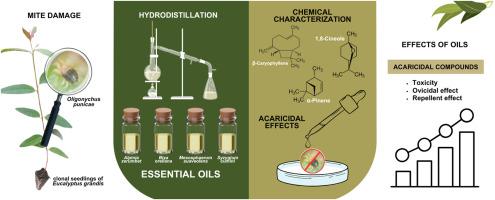大桉树无性系幼苗上泽木、苍木、沙叶和沙木精油的化学成分及杀螨活性研究
IF 2.5
2区 农林科学
Q1 AGRONOMY
引用次数: 0
摘要
Oligonychus (Oligonychus) punicae (Hirst)(螨目:叶螨科)是一种植食性螨,对各种作物造成严重损害,包括大桉树,其侵染可导致叶片变色,光合能力降低和整体植物胁迫。由于其经济重要性,需要可持续的控制策略。精油(EOs)已成为管理植食性螨虫的有前途的工具,但它们对水蛭的影响仍然很少研究。本研究评价了采自青花苜蓿(Alpinia zerumbet)、黄花苜蓿(Bixa orellana)、黄花苜蓿(Mesosphaerum suaveolens)和黄花苜蓿(Syzygium cumini)的果胶的杀螨潜力。采用水蒸气蒸馏法提取,气相色谱-质谱联用分析。通过毒力、杀卵、驱避试验及对种群生长率的影响评价杀螨活性。主要成分以单萜类和倍半萜类为主(占5%),不同种间成分不同。毒力试验结果表明,在LC50时,浮藻油的致毒力最高,为0.55 μL/mL。在LC90条件下,紫斑拟南蝽和大角小蠊的毒力比(TR)分别为9.1和5.6。所有的卵子存活率都降低了50%以上,其中未孵化卵的存活率达到79.25%。暴露于EO下的种群增长率仍为正,但与对照组相比,所有处理均显著降低了种群的内在增长率。在亚致死浓度下,所有绿僵菌均表现出驱避活性,其中绿僵菌表现出最高的驱避活性。这些结果突出了EOs作为有效杀螨剂的潜力。虽然没有一种油在所有参数中都表现出色,但每种油都表现出特定的优势,支持它们单独或组合使用,在综合虫害管理计划中互补使用。本文章由计算机程序翻译,如有差异,请以英文原文为准。

Chemical composition and acaricidal activity of essential oils from Alpinia zerumbet, Bixa orellana, Mesosphaerum suaveolens and Syzygium cumini against Oligonychus punicae on clonal seedlings of Eucalyptus grandis
Oligonychus (Oligonychus) punicae (Hirst) (Acari: Tetranychidae) is a phytophagous mite that causes significant damage to various crops, including Eucalyptus grandis, where infestations can lead to leaf discoloration, reduced photosynthetic capacity, and overall plant stress. Due to its economic importance, sustainable control strategies are needed. Essential oils (EOs) have emerged as promising tools for managing phytophagous mites, but their effects on O. punicae remain poorly studied. This work evaluated the acaricidal potential of EOs from Alpinia zerumbet, Bixa orellana, Mesosphaerum suaveolens, and Syzygium cumini. EOs were extracted by hydrodistillation and analyzed by GC-MS. Acaricidal activity was assessed through toxicity, ovicidal and repellent tests, and effects on population growth rate. The main constituents (>5 %) were mainly monoterpenoids and sesquiterpenes, with composition varying among species. Toxicity tests showed that at LC50, the oil of B. orellana exhibited the highest lethality (0.55 μL/mL). At LC90, both A. zerumbet and B. orellana were more toxic than S. cumini, with toxicity ratios (TR) of 9.1 and 5.6, respectively. All EOs reduced egg viability by over 50 %, with S. cumini reaching 79.25 % of non-hatched eggs. Population growth was still positive under EO exposure, but all treatments significantly reduced the intrinsic rate of increase compared to the control. All EOs also exhibited repellent activity at sublethal concentrations, with A. zerumbet showing the highest repellency. These results highlight the potential of EOs as effective acaricidal agents against O. punicae. While no single oil excelled in all parameters, each demonstrated specific strengths, supporting their complementary use, individually or in combination, in integrated pest management programs.
求助全文
通过发布文献求助,成功后即可免费获取论文全文。
去求助
来源期刊

Crop Protection
农林科学-农艺学
CiteScore
6.10
自引率
3.60%
发文量
200
审稿时长
29 days
期刊介绍:
The Editors of Crop Protection especially welcome papers describing an interdisciplinary approach showing how different control strategies can be integrated into practical pest management programs, covering high and low input agricultural systems worldwide. Crop Protection particularly emphasizes the practical aspects of control in the field and for protected crops, and includes work which may lead in the near future to more effective control. The journal does not duplicate the many existing excellent biological science journals, which deal mainly with the more fundamental aspects of plant pathology, applied zoology and weed science. Crop Protection covers all practical aspects of pest, disease and weed control, including the following topics:
-Abiotic damage-
Agronomic control methods-
Assessment of pest and disease damage-
Molecular methods for the detection and assessment of pests and diseases-
Biological control-
Biorational pesticides-
Control of animal pests of world crops-
Control of diseases of crop plants caused by microorganisms-
Control of weeds and integrated management-
Economic considerations-
Effects of plant growth regulators-
Environmental benefits of reduced pesticide use-
Environmental effects of pesticides-
Epidemiology of pests and diseases in relation to control-
GM Crops, and genetic engineering applications-
Importance and control of postharvest crop losses-
Integrated control-
Interrelationships and compatibility among different control strategies-
Invasive species as they relate to implications for crop protection-
Pesticide application methods-
Pest management-
Phytobiomes for pest and disease control-
Resistance management-
Sampling and monitoring schemes for diseases, nematodes, pests and weeds.
 求助内容:
求助内容: 应助结果提醒方式:
应助结果提醒方式:


